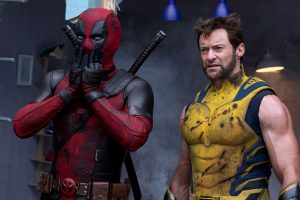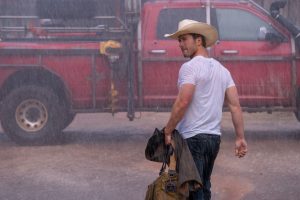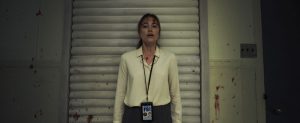Reviews include Deadpool & Wolverine, Doubles, and Mountain Queen: The Summits of Lhakpa Sherpa.
In Conversation with Team Deakins
April 10, 2021
By Rose Ho
Cinephiles generally know Roger Deakins for his visual artistry on films like 1917 and Blade Runner 2049, but the cinematographer has spent the last year mastering the auditory world with his collaborator James Deakins. They launched the Team Deakins podcast in 2020 and the series has quickly become an industry favourite as the husband-and-wife duo host conversations with various figures in the film industry. Team Deakins features directors such as Sam Mendes, Denis Villeneuve, and Joel Coen; actors like Frances McDormand, Joel Edgerton, and Jake Gyllenhaal; and a slew of behind-the-scenes talent — gaffers, camera operators, prop masters, costume designers, location managers and more! Team Deakins demystifies many aspects of filmmaking through educational and entertaining chats. I was honoured to speak with Roger and James shortly after the release of Team Deakins’ 100th episode. Below is an edited and condensed version of the interview.
Your podcast, Team Deakins, was started during the first coronavirus lockdown of 2020. Was it a product of the forced restrictions or did you have the idea percolating for a long time?
James Deakins: It is something that we had thought about beforehand. We had thought in December of the year before, or November, because we were doing a lot of press for 1917. After the Q & A’s, we would stand around and we would be asked the same questions, but it occurred to me that if we did a podcast, we would answer it once and be able to say, “Oh, it’s there!” Plus, we do have a website where we answer a lot of questions for people that are starting out. I didn’t know anything about podcasts, or really listen to podcasts personally, but I started looking into it. We started in late January, pulling it together and then did a conversation with someone.
Roger Deakins: We did Franz Kraus [of] ARRI first, and that was in-person.
James: We released that later because I didn’t know what I was doing quite frankly [laughs]. I had to figure out how to fix everything. But then it just started coming together. And then the pandemic came, which gave us a little bit more time, and it was a project for us during the pandemic.
Roger: When it started, it was more about our work together and about our small crew of people we knew and people we worked with. Then it just sort of expanded because of the [pandemic]. But the idea and the whole thing started prior to the pandemic almost as an extension of the website.
James: When you’re shooting a movie and then you bring it into editing, it has a whole new life. While we were doing it and creating it, it took [on] its own life. We found while talking to people, “collaboration” just kept coming up. It’s something we really do believe in, but now we’re finding out that everybody does, which is great. We were talking to people that did the same craft, but did it differently, so that was really interesting to us.
Roger: It was actually a great excuse to talk to people that we’ve always admired, but [who are] not necessarily directly connected to film. We talked to Alex Webb and Harry Gruyaert, who are two of my all-time favourite still photographers, so to get to talk to them and actually get to know them — it’s been really great.
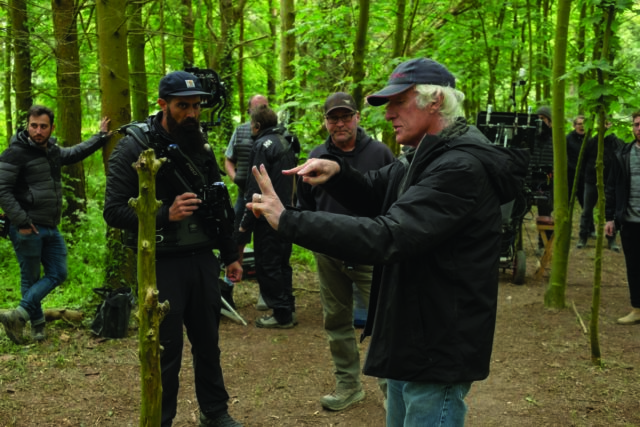
How did you personally find transitioning from the visual to the auditory realm?
James: Very, very, very difficult. I realized I didn’t know anything about sound. It’s just a different world. I work in Adobe Audition and I worked a lot in spectral analysis because it showed a visual picture of the sound. A different color was a different loudness, the pitch, and all that. I realized that I could relate to that because it was visual, but it was not easy at all. And because we’re perfectionists, it had to be perfect.
Roger: It was really hard for me as I’m not a very talkative person [laughs]. So to get on these Zoom calls — maybe I should have done it many years ago!
James: But I think we both have a natural sense of curiosity. We forget that we should be nervous because we’re so curious as to [say], “Wait a minute. So what does that mean about this?” So it’s been fun.
Roger: The people we talk to have such a shared interest [so] it’s not hard. You forget that you’re doing it for public consumption. Pre-COVID, when we used to have dinner parties with different cinematographers, we’d be talking about life and film — what we what we all love doing. In a way, we’re doing that on the Zoom calls.
James: It’s funny because somebody told us, “Listening to your podcast is like being at your house for dinner, listening to these incredible conversations.” And that became our goal post. We thought, “Yes, that’s exactly what we want.” We see it as conversations. We do not see it as interviews at all because that would be boring to us.
You’ve talked to many people working in the industry, most notably, the crew members. These people don’t usually receive the same attention or acclaim as directors or actors. What are some of the things you’ve learned about your colleagues? And what is something you hope your audience learns about these lesser heard but unique voices?
Roger: Some are too shy to be on it [laughs]!
James: I think that it shows how complex their job is. You may think the prop guy is only making sure that the forks are on the table, but the thinking that has to go into it, and the way they have to view a script… I think it’s really important for everyone to know that as well and to know what their job entails because then you have a better appreciation of what they do. If you’re a director, you can use them better because you realize, “Oh, they also cover this.” One producer said to us, “The thing is about the podcast is it’s talking about all this stuff that we kind of know about but we never talk about.”
Roger: I think it’s really important that more people are appreciated. It is a collaborative process. Films wouldn’t be made without those people that do it. The people on the floor that probably worked longer hours than the director or the producer and certainly the actors, they deserve to be recognized. We wouldn’t do it without including them. It wouldn’t be right.
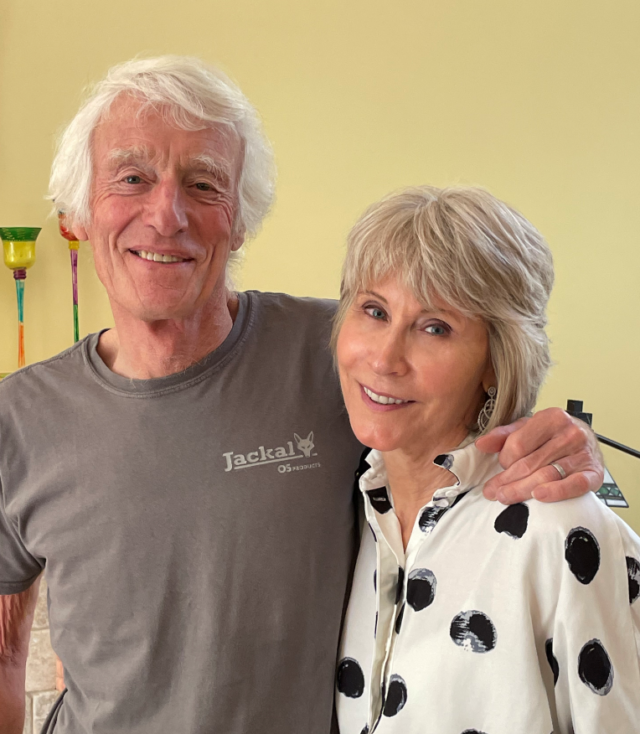
While listening to the many Team Deakins episodes, I was struck by the way you and many of your guests talk about the experience of working on set, likening it to a family. Do you find that your podcast is a way to reconnect with that family-like environment?
James: It’s been great because we’ve talked to people we haven’t talked to in a long time, and it is our social connection.
Roger: It’s not being on set though. That’s a different experience. We really miss that. There’s no way to recreate that or compensate for that. It is what it is. We’ve not been on a set for nearly two years, really.
James: It’s [been a] really weird year and a half.
When reflecting back on almost a year’s worth of Team Deakins episodes, what do you note about how the podcast has evolved?
James: It definitely has gotten very relaxed. We have a format now. We look forward to it. In the beginning when you create something like this, you may say, “Really? Is anybody else going to be interested in this?” And that was sort of our feeling, like, “Well, we’ll do it for maybe the ten people that it might interest.” So the feedback that we’re getting is actually startling.
Roger: It’s been quite amazing. When you see the numbers of people that are listening in all over the world, it’s quite touching really.
James: Maybe we’re getting better at giving them a platform, knowing the questions to ask to help bring forward what it is that they do. We realized that it’s also how people do it differently. We’re very interested in that and so we go for that [to] try and get their opinions about things. It’s very much a part of our life right now. We do it several times a week. And I cut every day.
Roger: How many [have] we got now ready? Cut and finished?
James: Probably 50 or 60 in the pipeline. I try not to count them because it’s just a little overwhelming at times. But it’s nice too because we sometimes get some emails from people. Like we got an email from Carroll Ballard’s daughter, who said, “Would you ever consider doing my father?” And we had been talking about him with Caleb [Deschanel] and John Toll. And [we said], “Yeah!” That was fantastic.
Roger: It’s been nice, hasn’t it? I think everybody we’ve talked to has been so nice and so open about talking about themselves and their approach and how they got started. I really think that — for me — that’s the great asset of doing it for people who are interested in getting into the film business. I mean, that’s why we’ve got the website. When I started out, growing up in the countryside, no connection to the film business or anything… it’s daunting. So for somebody to be able to understand how different the approach can be and the journey can be, I think that’s really interesting and reassuring.
You have some episodes that turn the tables of questioning. Do you prefer asking the questions or being in the hot seat?
James: Turning the tables means we don’t have to do the prep, which is nice [laughs]. There’s been a great response to that, so I’m starting to think that maybe we also do some episodes that just focus on a film — maybe somebody else’s film — because people are responding well, and they want to hear those details behind the shots.
Roger: Sometimes it’s really about the minutia, the little details of how a scene was got together — the happy accidents or the amount of prep that goes into something. It is nice to talk to people that you don’t know. For instance, we talked to Neil Jordan, so it was a great excuse to rewatch all of his movies. It was great to revisit these wonderful movies before you talk to somebody.
James: Because we take our homework very seriously, we do watch people’s movies. Over this year, we have seen movies that we didn’t even know existed. Sometimes a movie gets buried when it comes out and oftentimes that can be a really lovely movie. We’ve found some real gems.
Roger: They’re pretty great. We watched Alexander Nanau‘s earlier documentaries and we watched all of Andrey Zvyagintsev‘s movies. It’s just great to have that excuse.
I think it’s fair to say that you’ve spoken to many people who admire your work, Roger, but you mentioned you also use the podcast to talk to some of the people you find inspiring. Can you talk a bit more about how it was for you getting to chat with them and how their work might have influenced your own?
Roger: Sadly, most of the people whose work influenced my own are probably dead. Edvard Munch, painters, other filmmakers from the past. I mean, so many. And friends that have died [like] Conrad Hall and Haskell Wexler. People we would have loved to talk to on this podcast. How directly anybody influences your work, I don’t really know because you are a product of everything you’ve experienced, [aren’t] you? It’s not just art. It’s not just [a] painting on the wall or another picture or movie or something. It’s where you’ve grown up. The things you’ve seen. The kind of environment you’ve been [in].
James: We also had the opportunity of talking with Alexey Rodionov, who was the DP on Come and See, which is an amazing film. Someone reached out to us and said, “Would you consider him?” And we didn’t even think about how could we reach him. And to be able to talk to him — because it is one of our favorite films — and to hear his thoughts on how they chose shots —
Roger: — and just how they operated and the length of time it took to shoot and how they shot in continuity, and the whole thing. It’s so interesting how the process was for a film that is a classic. It’s probably the most acclaimed war movie ever made. It was interesting to get that insight.
For James, something that I’ve learned throughout the podcast is your role as digital workflow consultant. Can you talk about how it was carving out that role? Was there a lot of resistance in the beginning?
James: It was really tough because I was doing it for a long time behind the scenes and it would take a while to get production to understand the way that we worked. And it was tough to be trying to do something and to be disregarded like that. It’s tough, but I didn’t have an option because I wanted to support Roger and I wanted to make sure I was covering his back. As it progressed, we realized, “Wait, this is really serious.” I took a title, which helped. A lot of times producers in the beginning don’t understand because there isn’t another person that really does this. They don’t understand it in the beginning, but they understand it halfway through.
Roger: The thing was you [have to] understand that James was the script supervisor. And most of the crew that we work with, James has known some of them longer than I’ve known them. That is part of the family. After she gave up scripting, and we decided we wanted to be together and that she was going to come and help be part of the shoots that I was cinematographer on, then she was part of that crew. And it kind of grew out of that, didn’t it?
James: It took a while, but I think with the title it enables me to come in right from the start, and then allow them to see the way that we work. When we were doing 1917, whenever there was a camera question or issue or something, they came to me because they weren’t pulling Roger off the set. They would come to me and I would either know the answer or would just find out for them. Or know what we needed in two days’ time. So it makes a lot of sense because it allows the camera crew to be focused on what they’re doing right at the moment and I can look into the future.
Roger: Ironically, film production has got more and more complex. When I was running around with a camera on my shoulder, shooting film with no monitor, things were quite simple. But now with digital capture and all the backup stuff and the different camera movement systems and drones, it’s become quite a complex thing, really. I wish it was simple [laughs]!
James: Things have changed so there’s all different kinds of delivery requirements by the studio. It’s best to know that up front because that sometimes can change your aspect ratio or what you’re protecting in the frame, so to have one person that’s checking all that stuff and then able to follow it through [is important].
Roger: That’s the thing. Any production person — the supervisor or production manager or coordinator or whoever — they’re not connected to the camera department on a day-to-day basis. They’re not connected to the people that are timing dailies. The post production houses, the visual effects. There’s nobody that coordinates as well as James does.
I can’t go without asking about how COVID has affected you. You’ve already mentioned you haven’t been shooting for a while.
James: It’s been strange because we’ve never really stopped this long and it’s been really nice being home. Having the podcast has at least given us that structure because we have deadlines. But also talking to people [makes us] realize what we’re missing. The movies that are trying to shoot during this time period have all these protocols, and those protocols make the working structure not what we would necessarily want to work in — two people on the set at once — because it’s a collaborative thing. So how do you do that?
Roger: Part of what we really enjoy about filmmaking is that collaboration, that close contact with a whole group of people and to be doing things remotely and be in spacesuits — I’m sorry, it’s just not us. I just don’t feel I could work like that.
James: It’s interesting because a lot of the filmmakers we’re talking with also say that they don’t want to work that way. I usually try and pull out mentions of COVID from the podcast only because it dates it.
Roger: Makes it a bit time-specific. Hopefully this won’t go on forever.
James: But also because it’s the same thing. Everybody feels the same, so I just didn’t want to repeat that over and over.
Do you have predictions for the future of filmmaking after COVID? For example, digital solutions?
Roger: There’s lots of digital solutions. Every film they make can be animated. “We all do it from home on a computer.” I’m afraid some people are actually looking at that. The whole effects world, the use of fake backgrounds or LED screens as backgrounds — great, but I’ve got no interest in that whatsoever. Absolutely none. Maybe I’m old fashioned but I like being on a set with real things with real people and interacting with other people and finding how to tell a story in a reality. That said, we do work on animated films sometimes, but that’s a different thing. The idea of doing live action that’s not live action — I’ve just got no interest in it at all.
So what are your plans for the podcast after COVID when you can get back to shooting again?
James: We might take a little break. But I think it’s not a bad thing to continue.
Roger: We could always add to it more slowly. I mean, we’ve got a schedule of doing, publishing two a week, but we don’t have to do that.
James: That was my bright idea [laughs].
Roger: We don’t have to do it. We could stop tomorrow. It’s not like a commercial enterprise.
James: But it’s been helpful to a lot of people, so I’m actually going back to the beginning episodes and — because I know more now — taking the noise out and cleaning them up a little bit.
Roger: It’s a great archive apart from anything else. I hope they survive because it’s a wonderful sort of record of people’s takes. Individuals. Who they are and how they feel. I just hope somehow they get to last somewhere.

